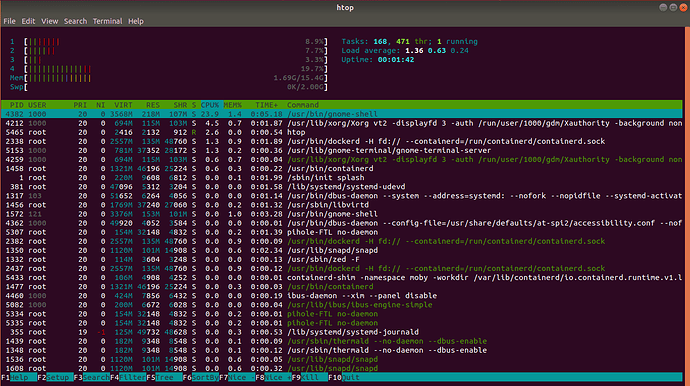dimitarvp
Laptop with external monitor: need advice on which Linux distro/WM to use
Hey everyone,
I am about to receive a work laptop: the Lenovo T490 (could be changed to T490s, unclear as of yet).
I am after the perfect Linux + WM/DE combo that allows for seamless work on a main display at 2560x1440 and a secondary display at 2560x1080, with the best font rendering that Linux can offer, and without requirements about [much] external hardware.
Which distro?
I have mostly made up my mind that I am going to use Manjaro. Arch itself is amazing – extremely fast (it beat out my iMac Pro on a few I/O tests so I’d guess kernel overhead is smaller), well-maintained software repositories, packages kept up to date, and it has never broken a working X11 configuration (unlike Debian and Ubuntu, although that was in the far past so I might be very unfair to them here). And the out-of-the-box everything-is-working trait of Manjaro made it my favourite.
I have found that Debian/Ubuntu and the like aren’t my cup of tea in general. apt seems to nag you too much about dependencies at just the right time when you are simply trying to install a piece of software and move on with your work. I know this isn’t a technical evaluation – but I am a human, not only a programmer, and those distros did rub me the wrong way enough times to start wanting to avoid them.
I’ve heard good things about Pop!_OS and sometimes Slackware but I am not willing to invest too much time in learning a new distro’s peculiarities, I admit.
Still, if you have an advice – that includes a very quick onboarding guide, please! – shoot it my way. I’m still curious, just don’t want to sink too much time.
Which WM?
I’ve been using XFCE 4 for a long time when I worked in Linux (most of my career). It’s nothing beautiful or even that much customisable but I don’t have big requirements either. I’d like to have multiple workspaces and be able to bind keys to literally any and all command, move some bars to the 4 different corners of the desktop, add a few monitoring widgets here and there… and that’s pretty much it. I don’t even care about sound or Bluetooth. Very likely I’ll buy an USB-to-Ethernet adapter and won’t use Wi-Fi either.
Still, if you have a recommendation – with some screenshots if it’s not too much trouble – I’d love to read about (and see) them. I feel that I never really went deep customising a Linux WM and I know I missed out so I can see myself sinking some weekend hours in trying to invent a badass UI that I like.
Options I am aware of
- KDE. Don’t know, always felt big and bloated and booting a brand new Ubuntu KDE to see 3.5GB of RAM already taken brings too many Windows 10 memories. Should a WM / DE be that heavy out of the box? I dislike it on that basis alone.
- GNOME. It gets a lot of praise these days and I admit I am poorly informed on it, including resource usage. Any downsides?
- Cinnamon. Zero clue. Heard praises but I know absolutely nothing about it. Would you recommend it and why?
- i3. Also zero clue. Used it once long ago, kind of liked it but didn’t want to spend time customising it and ditched it. Nowadays I am more open to tinker with my WM / DE and make it my own.
What I’m looking for
- Visual cleanliness. I don’t need macOS level of polish although I’d enjoy it. Good no-nonsense UI with enough ability to move things around and a few dark themes is good enough.
- Excellent font rendering and good [re-]scaling capabilities. This is my top requirement. The laptop’s builtin display is at 2560x1440 while the external display is at 2560x1080. Would that be a problem for the current WMs / DEs? I want the best font rendering possible in Linux without weird glitches when moving windows between both displays, or grainy fonts because both displays have different PPI.
- As less bloat as possible. I don’t want mail server, httpd, ftpd etc. Let me install
sshdor LibreOffice if I want to, and get out of my way. Give me a good working system out of the box, with minimal dependencies. - As much speed as possible. I’ve been blown away by what an i3 CPU laptop with a pretty regular SSD (no more than 500MB/s read/write) can do compared to beasts like the iMac Pro (the observation was under Manjaro/XFCE). I am looking for a system whose resources are reserved for me and not for the 500 daemons doing hell knows what (looking at you, KDE).
- Easy isolation? I know this is a work in progress in the Linux WM / DE space and only Qubes seems to have gotten this [somewhat] right. Is there a way to prevent any program to capture key presses, scan the clipboard etc. privacy intrusions? I’d like to have and enforce an easy to setup policy which does common sense isolation. But is that even possible nowadays in Linux at all?
Any thoughts you might have, I’d love to hear them. As you might have guessed, I am particularly interested in low-setup Linux installs 
Most Liked
muelthe
I coudn’t possibly recommend a distro that I know for sure supports the resolution you’re using (I don’t have a display capable of that, anyway  ) and my own experience has been limited to Centos (headless) and Ubuntu for my dev environment.
) and my own experience has been limited to Centos (headless) and Ubuntu for my dev environment.
I can say that I know Ubuntu offers a kind of ‘try-before-you-install’ installer so you can just run it from a USB drive/key.
In addition (regarding Ubuntu), to some of your other requirements:
- It’s clean (subjective)
- You can opt out of the bloat by customising the installation
I haven’t ever tested it for performance, although from personal experience I cannot say that I’ve ever noticed any particular issues, but that will depend greatly on use case.
As for isolation, again I’ve not used it, but there are a few articles that discuss and introduce it: https://docs.ubuntu.com/core/en/guides/intro/security
I’m not trying to sell Ubuntu (edit: I know you expressed a dissatisfaction for it); it’s the OS I’ve used predominantly for the last couple of years when I wanted a gentle intro to working on a Linux system and seem to have stuck with it since 
OvermindDL1
No configuration, it’s all automatic and comes with every wayland setup I’ve seen. ![]()
Yes it does, significantly so. And normally ‘you’ wouldn’t set it up but the distro maintainer would.
A quick off-the-head list of bonuses of Wayland over X11:
- Faster.
- Lighter weight.
- Every program gets its own framebuffer.
- Built in compositor that actually prevents things like tearing.
- Interface agnostic, what I mean by this is you know how X11 is designed for a 2D screen? Wayland works for 2D, 3D like VR, etc… etc…, this means that when a program opens and it wants to, say, position itself precisely at coordinates 120x376 on the screen it can’t, because wayland doesn’t have a concept of a screen (though there are requests for ‘suggestions’ like that).
- A whole lot more I can’t really think of right now because headache from weather… ^.^;
However, there are some bonuses of X11 over Wayland:
- Many decades of development means it’s fairly bug free given the limitations of its architecture (which are pretty limiting, for example in subpixel aliasing).
- Remote UI running via an X tunnel (wayland will get something similar once the renderpipe extensions are complete, looks like this year).
- Can be faster if the hardware has no vulkan support (one reason wayland is faster is that vulkan is used to accelerate a lot of operations, though even without it one wouldn’t call it ‘slow’ by any stretch).
- Um, I think there used to be some xwayland compat that caused some programs to not do things like position right, but I think those were solved in 2019…
In general as it stands now, just use whatever your distro provides. Like I think Kubuntu uses wayland if it thinks you have a great hardware setup for it otherwise it uses X11, its all transparent.
For note, NVidia closed-source drivers do not work with xwayland (you can’t 3d accelerate with nvidia closed source drivers so no, like, X games or so, which is mostly Steam), so if you have nvidia Kubuntu would run you with X11 regardless. The reason is that nvidia is refusing to support the vulkan standards for backend framebuffers and instead of pushing their own proprietary thing that no one else uses or really ‘can’ use. However there are people writing converters from nvidia’s garbage to the standards that will be done ‘sometime’, but its slow going because nvidia the past 5 or so years has really exceptionally pissed-off the linux development community with their utter stupidity. On the plus side Intel and AMD both have open sourced their GPU drivers and merged them together to develop together, so they are utterly rock solid and fast.
Exadra37
So it looks you are only looking for someone to say what you wan to listen ![]()
Ubuntu breaking X11 its really from the past, like 2012, last time I remmeber to have the issue, that was also when I started to use Ubuntu, thus maybe was a rookie mistke, spcially when I was comming from Windows.
I don’t know Manjaro, but what kept me on Ubuntu is really the out-of-the-box just works.
Ubuntu 18.04 here, and a picture is worth 1000 words, thus here it is one after a restart:
I think that this is more a concern about if the graphics in the motherboard of your new Laptop support it.
You can always use the selinux or apparmor to tight things up.
Also you can use LXC containers to run another Linux distro inside your current Linux distro. So like one for work and another one for personal use.
My approach is to use heavily docker for my developer flow, everything runs inside a docker container, even my code editor.
For personal use in sensitive stuff I always use Firefox from inside a docker container, like when banking.
Popular Linux topics

Other popular topics

Categories:
Sub Categories:
Popular Portals
- /elixir
- /rust
- /ruby
- /wasm
- /erlang
- /phoenix
- /keyboards
- /python
- /js
- /rails
- /security
- /go
- /swift
- /vim
- /clojure
- /emacs
- /haskell
- /java
- /svelte
- /onivim
- /typescript
- /kotlin
- /c-plus-plus
- /crystal
- /tailwind
- /react
- /gleam
- /ocaml
- /flutter
- /elm
- /vscode
- /ash
- /html
- /opensuse
- /zig
- /centos
- /deepseek
- /php
- /scala
- /lisp
- /react-native
- /textmate
- /sublime-text
- /nixos
- /debian
- /agda
- /django
- /kubuntu
- /arch-linux
- /deno
- /nodejs
- /ubuntu
- /revery
- /spring
- /manjaro
- /lua
- /diversity
- /markdown
- /julia
- /slackware










